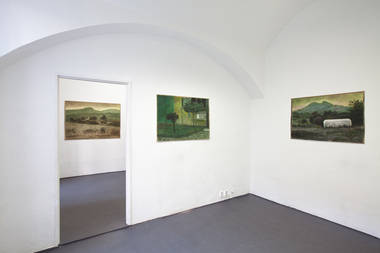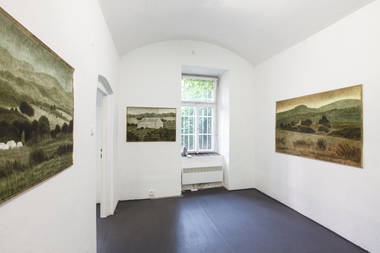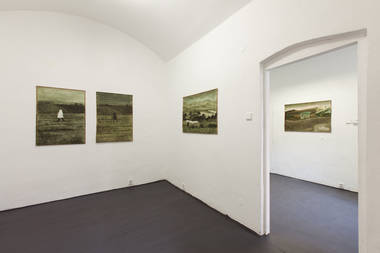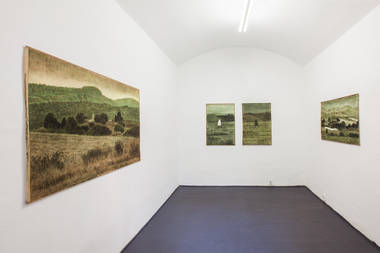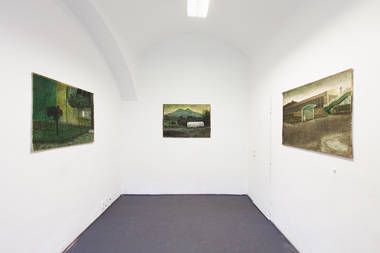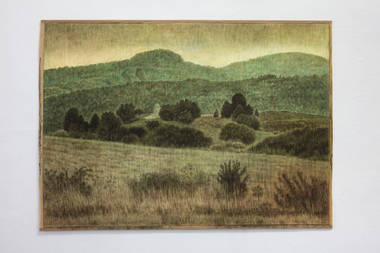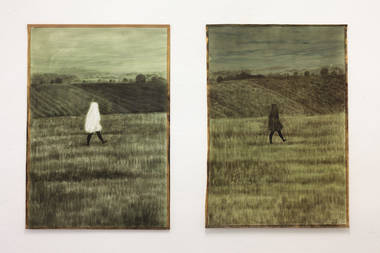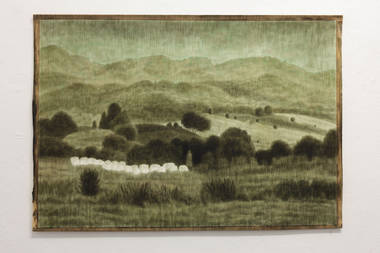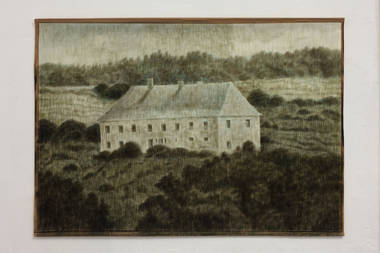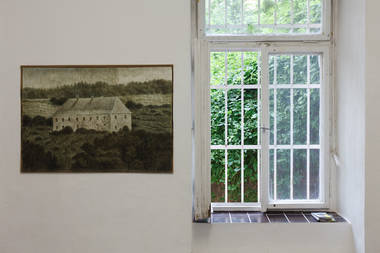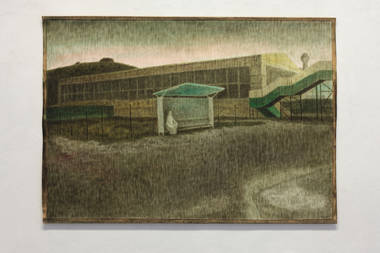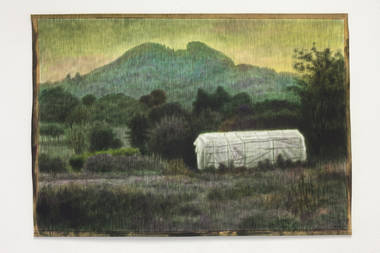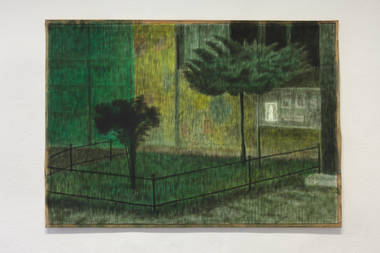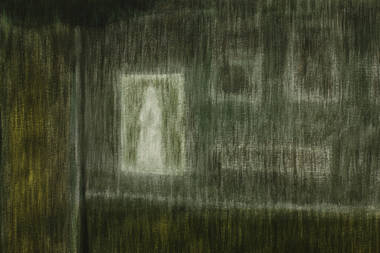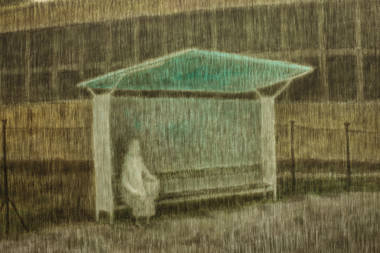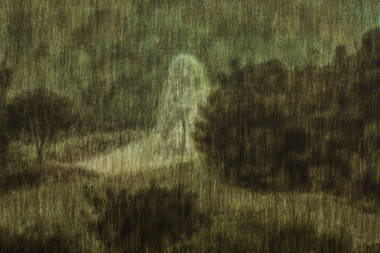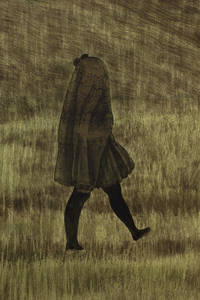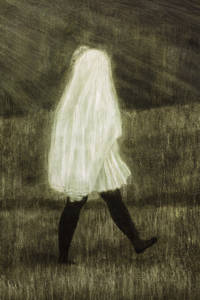Alžběta Skálová: Singing subsided and the night closed in
30. 6. – 30. 7. 2015
opening: 30. 6. 2015
curator: Gabriela Kotiková
Gabriela Kotikova: Alžběta, you studied at the Academy of Arts, Architecture and Design in Prague, firstly in the Jiří Barta´s studio of Film and TV Graphics, and then at Juraj Horváth´s studio of Illustration and Graphics. Does it meant that in the beginning you were interested in animation and you wanted to make films?
Alžběta Skálová: Even though I was always oriented to illustration, I wanted to have wider possibilities ahead of me, in the animation studio it was possible to work with the material, with the puppet and with the story at the same time. Ever since my childhood I have enjoyed creating various heroes, characters, puppets, and expressing myself not only in a 2D way. And I also thought that I could pursue illustration, too. After three semesters at the animation studio, as I had grasped the classical hand-drawn animation, I completed an internship at the studio of illustration. Juraj Horváth had just been appointed its head, and I decided I wanted to make a book. And so I stayed there. Horváth´s studio was as open as the animation one. I enjoyed it a lot.
GK: What is your experience from the stays in Paris (École Estienne, 2005) and in Baltimore, USA (Maryland Institute College of Art, 2007)?
AS: The stays were definitely beneficial. The approach of the students and the teachers, and also the school system as a whole, were rather different, namely in Baltimore. They put much bigger emphasis on self-presentation and on the ability to reflect on one’s own work and that of others. In the US it filled almost half of the time at school. Logically, as the school was very expensive, the students respected it totally and the school offered a lot in return. They had five galleries on the school campus itself, with exhibitions changing every week, and they also had their own art-shop where the students worked, etc. The situation has changed in the Czech Republic, too, at least in my opinion, but during my studies at AAAD, nothing like this was there. At both schools the system was like at a secondary school – they checked the attendance, etc. But everything had both advantages and disadvantages. They approached students by a positive motivation and after I returned to the Czech Republic, it was the small pond of various “impossibilities” again.
GK: Did you feel they focused more on the computer work or do they also maintain the tradition of classical book making techniques and animated film like in the Czech Republic?
AS: I was in Baltimore in 2007. At that time I was surprised by the growing interest in “traditional” techniques; I took classes in intaglio, calligraphy and drawing, and the interest of the students in these techniques grew. The posters for concerts were made using silkscreen – a totally different world. It was positive, but it still hasn´t got here, at least in my opinion. The trend at our school is the opposite – I mean of the administration. The intaglio workshop has been moved outside the main building. Maybe after everyone will have forgotten this handcraft they will be interested again :-) In Baltimore they had great technical facilities; the computer work was a natural thing, but there was a tendency to go back to traditional and manual ways. At least this is my experience.
GK: You are a distinctive and respected figure in the field of illustration for children. However, your own art work is, in my opinion, rather inconspicuous. I saw the exhibition in the Art in Box Gallery of your and your brother´s works. Can you say something about these paintings? What do they have in common? What technique did you use?
AS: I exhibited mainly the paintings made during my residency in Český Krumlov where I had the opportunity to create my own things, which is usually impossible, as I make my living as an illustrator. A residency, or simply a detachment from everyday work, is for me the only opportunity to concentrate for a longer period of time. The paintings were based on the technique which I made up for the illustrations of African fairy tales. (Little Black Fairy Tales, Baobab, 2010) and I felt like using it elsewhere, too. Those were plaster coatings in a rather limited range, which I then etched. It involved certain randomness which is useful, I think. It was free painting, but again, there was a story involved – partly inspired by Krumlov, partly by my dreams; all was very intuitive.
GK: The current exhibition at the Jelení Gallery came into existence at the residency in Bánská Štiavnica. For your works you used an unconventional technique of painting on paper with a dry brush. Could you say something about it? Is it common to use it for such big formats? The technique appears to be very time-consuming.
AS: Again it came into existence spontaneously. I had the opportunity to concentrate for two months in a beautiful volcanic landscape around Bánská Štiavnica. For about two weeks I painted spontaneous records, small watercolor diaries, and step by step I got to a bigger format. I used the same technique earlier for one of my (so far the biggest) paintings. But I was still at school back then, and there were other challenges to face. I got back into it, as I needed to express gloom. Yes, it was demanding, but very adventurous, too. You have to concentrate so that you don’t make a wrong stroke of the brush, so that you don’t make a mistake.
GK: The exhibition has a peculiar, rather dim atmosphere; it evokes the feeling like just before a sunset. Does it mean that this moment is very strong in the course of a day, but very short?
AS: A long time ago, at school, I painted such a monochrome landscape in plain air. Here, however, I was seized by a certain moment of light, when birds stop singing; by the dusk, where the last white accents appear and one can confuse them with anything. It is a very strong moment for me. Only after I had painted the two figures, I realized that one of them is the day and the other is the night. The white one simply didn´t suffice. I just let the place influence me – the folklore, the remnants of industrial mining, the artificial water reservoirs, the intensive greenery…
GK: Thank you for the interview.
Jeleni Gallery exhibition program is possible through kind support of Ministry of Culture of the Czech Republic and Prague City Council
Media support: Artycok.tv, ArtMap and jlbjlt.net
